Welcome to our comprehensive guide on flame moss, also known as Taxiphyllum sp., and its role in aquascaping.
Flame moss is a highly sought-after aquarium moss that has gained popularity among freshwater aquarists for its unique characteristics and versatility in creating stunning underwater landscapes.
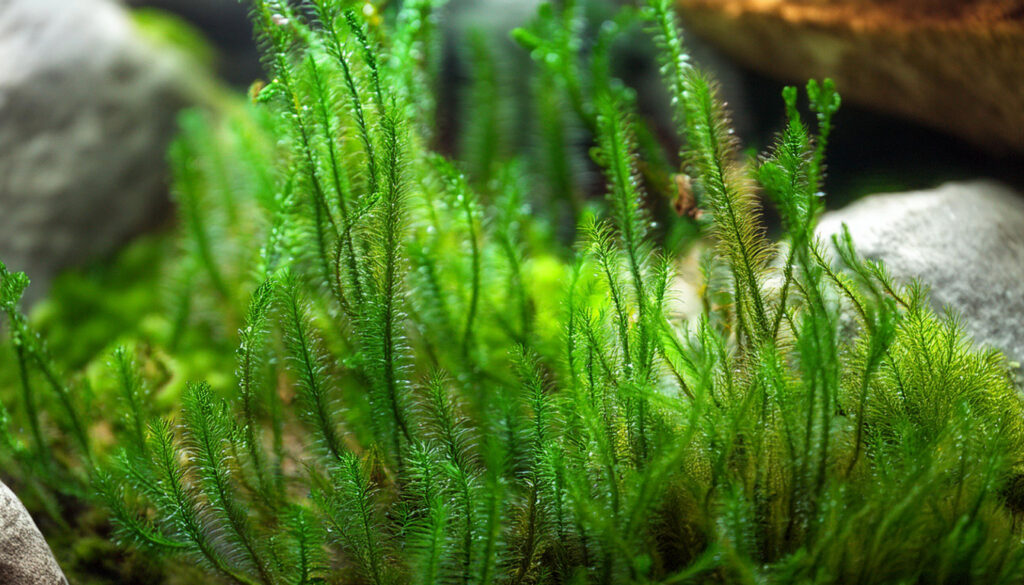
In this article, we will delve into various aspects of flame moss care, from its growth patterns to integration into aquascapes, propagation techniques, benefits to aquarium inhabitants, maintenance tips, common challenges, and accessorizing options.
Whether you’re a beginner or an experienced aquarist, this guide will provide you with valuable insights and techniques to incorporate flame moss into your aquascaping endeavors.
Key Takeaway
- Flame moss, also known as Taxiphyllum sp., is a popular choice for aquascaping due to its unique growth pattern and flame-like appearance.
- Understanding the history, origin, and natural role of flame moss can help in creating optimal conditions for its growth in aquariums.
- Proper lighting and water parameters are essential for enhancing flame moss coloration and maintaining its health.
- Integrating flame moss into aquascapes offers endless creative possibilities, such as attaching it to driftwood or combining it with other aquatic plants.
- Various propagation techniques, including fragmentation and spore dispersal, can be employed to propagate flame moss and expand its coverage.
Quick Stats
| Attribute | Details |
| Scientific Name | Taxiphyllum sp. |
| Common Name | Flame Moss |
| Origin | Asia, particularly Southeast Asia |
| Height | 3-10 cm (1.2-4 inches) |
| pH Range | 5.0 – 7.5 |
| CO2 Requirement | Low to Moderate |
| Growth Rate | Slow to Moderate |
| Care Level | Easy to Moderate |
| Color Form | Green with reddish tips |
| Water Conditions | 18-28°C (64-82°F), adaptable to a range of water parameters |
| Max Size | Typically remains small, forming dense mats |
| Lighting | Low to Moderate |
| Supplements | Minimal; benefits from occasional liquid fertilization |
| Placement | Foreground to Mid-ground |
| Propagation | By division or fragmentation |
What Is Taxiphyllum sp. (flame moss)?
Taxiphyllum sp., commonly known as flame moss, is a popular aquatic plant among aquascaping enthusiasts. Its vibrant green color and unique growth pattern make it a sought-after choice for creating visually stunning underwater landscapes in aquariums.
Flame moss belongs to the genus Taxiphyllum, which encompasses several moss species found in freshwater habitats. This particular species, Taxiphyllum sp., is known for its flame-like appearance and upright growth habit.
History And Origin
The intriguing history and origin of flame moss sheds light on its journey into the world of aquascaping. This captivating aquatic plant was first discovered in Southeast Asia, where it thrived in lush, natural aquatic ecosystems.
Over time, flame moss gained recognition for its unique appearance and ability to enhance the aesthetic appeal of aquariums.
Physical Characteristics
- Frond Shape: Flame Moss features slender, elongated fronds that taper to a point. The fronds are arranged in a flame-like pattern, hence the name “Flame Moss.” The overall growth habit resembles a fiery flame, with fronds extending outward in various directions.
- Color: The fronds of Flame Moss exhibit a distinctive bright green coloration, adding a vivid and eye-catching contrast to the aquarium environment. The vibrant green hue of Flame Moss enhances its visual appeal and makes it a desirable choice for aquascaping.
- Texture: Flame Moss has a fine and delicate texture, with thin and feathery fronds that provide a soft and naturalistic appearance. The fine texture of the moss adds depth and dimension to the aquascape, creating a lush and visually appealing landscape.
- Growth Pattern: Flame Moss exhibits a creeping or spreading growth pattern, with fronds extending horizontally along the substrate or attaching to hardscape surfaces such as rocks, driftwood, or aquarium decorations. The moss forms dense mats or carpets over time, covering surfaces with its intricate and flame-like foliage.

Lighting Requirements For Enhancing Flame Moss Coloration
Proper lighting is crucial for enhancing flame moss’s vibrant coloration. Adequate illumination promotes the robust growth of this aquatic plant and intensifies its fiery green hue.
It is important to provide moderate to bright lighting conditions to achieve optimal results but avoid excessive light intensity that can cause algae problems.
Water Parameters Essential For Flame Moss Health
Flame moss thrives within specific water parameters, ensuring its health and vitality in aquariums. Maintaining a stable pH level between 6 and 7.5, temperature between 68°F and 78°F (20°C to 26°C), and water hardness between 2 to 10 dGH creates an ideal environment for flame moss.
These parameters closely mimic its natural habitat, supporting healthy growth and development.
Optimal Temperature For Growth
- Temperature Range: Flame Moss thrives in temperatures ranging from 20°C to 26°C (68°F to 79°F). Within this temperature range, the moss exhibits robust growth and maintains vibrant coloration.
- Tropical Conditions: Flame Moss is well-suited to tropical freshwater environments commonly found in aquariums. It adapts well to the temperature fluctuations often encountered in home aquariums, provided that the fluctuations remain within the optimal range.
- Stability: While Flame Moss can tolerate slight fluctuations in temperature, maintaining stable water temperatures is essential for consistent growth and overall health. Rapid or extreme temperature changes can stress the moss and affect its growth rate and appearance.
- Heating and Cooling: Use a reliable aquarium heater to maintain stable water temperatures within the optimal range, especially in cooler environments or during colder months. Conversely, during hot weather or in warmer climates, consider using a fan or aquarium chiller to prevent water temperatures from exceeding the upper limit of the optimal range.
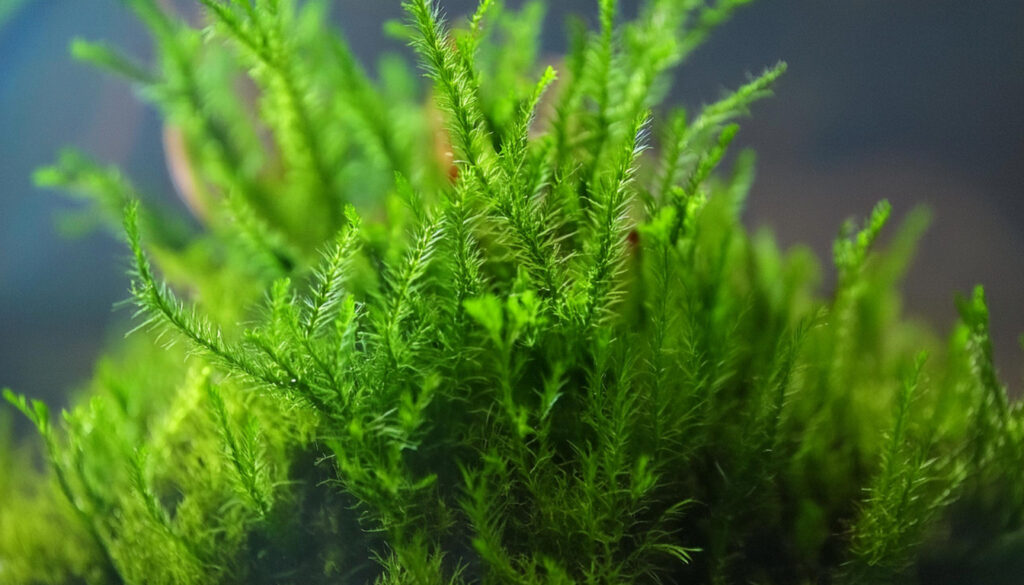
Choosing Substrates That Complement Flame Moss
- The choice of substrate is crucial in creating a suitable environment for flame moss. Opt for substrates that provide a solid anchor for the moss and help retain nutrients for healthy growth. Consider options such as nutrient-rich aquasoil or gravel with root tabs.
- These substrates can provide essential nutrients and support the root systems of your flame moss. Additionally, they can contribute to your aquascape’s overall aesthetics by enhancing the moss’s color and texture.
Placement Option
- Foreground: Placing Flame Moss in the foreground of the aquarium can create a striking visual impact and add depth to the aquascape. Arrange the moss along the front portion of the tank to create a lush and vibrant carpeting effect. Flame Moss’s creeping growth habit and fine texture make it well-suited for foreground placement.
- Midground: Flame Moss can also be positioned in the midground area of the aquarium to serve as a focal point or accent. Arrange the moss on rocks, driftwood, or aquarium decorations to create eye-catching focal points within the aquascape. Flame Moss’s vibrant coloration and unique growth pattern make it an excellent choice for midground placement.
- Background: While less common, Flame Moss can be used in the background of the aquarium to add texture and dimension to larger aquascapes. Attach the moss to tall rocks or driftwood structures positioned towards the back of the tank, creating a backdrop of lush greenery against which other plants and fish can be showcased.
RELATED: Cultivating Hemianthus Micranthemoides (Pearl Weed) For A Versatile Aquatic Oasis
Recommended Tank Size
- Nano Tanks: Flame Moss is well-suited for nano tanks and small aquariums with capacities ranging from 5 to 20 gallons (19 to 75 liters). Its compact size and creeping growth habit make it an excellent choice for foreground or midground placement in smaller tanks. Flame Moss adds visual interest and texture to nano aquascapes without overwhelming the limited space.
- Medium Tanks: For medium-sized tanks ranging from 20 to 50 gallons (75 to 190 liters), Flame Moss can be used as a versatile accent plant or background filler. Its vibrant coloration and unique growth pattern make it an attractive addition to mid-sized aquascapes, where it can be arranged on hardscape elements or attached to driftwood and rocks.
- Large Tanks: In larger aquariums exceeding 50 gallons (190 liters), Flame Moss can be utilized as a foreground carpeting plant or midground accent, adding texture and dimension to expansive aquascapes. Its creeping growth habit allows Flame Moss to spread and form dense mats or carpets, covering surfaces with its vibrant foliage.
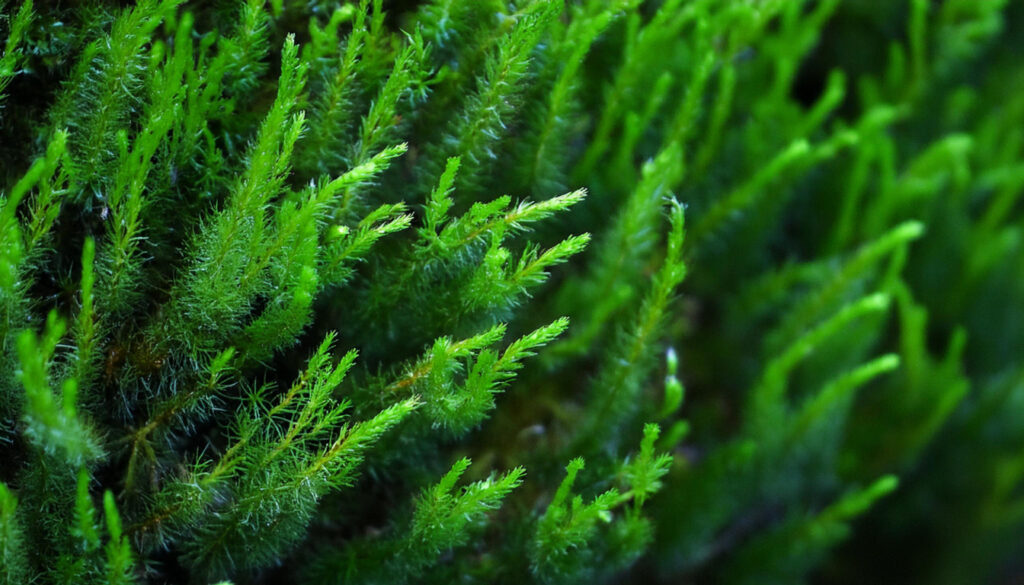
Combining Flame Moss With Other Aquatic Plants
To take your aquascape to the next level, consider combining flame moss with other aquatic plants. This integration will create a harmonious and diverse underwater landscape. Here are some ideas for combining flame moss with other aquatic plants:
- Combine flame moss with java fern: The feathery appearance of java fern complements the flame-like growth of moss, creating a dynamic and textured aquascape.
- Create carpeting effects with flame moss and carpeting plants: Combine flame moss with carpeting plants, such as dwarf hairgrass or glossostigma, to achieve a lush and carpet-like effect in your aquascape.
- Pair flame moss with Anubis: Anubias’ broad leaves and flame moss’s delicate texture provide an interesting contrast in both color and shape.

Nutritional Needs
- Macronutrients: Flame Moss requires essential macronutrients such as nitrogen (N), phosphorus (P), and potassium (K) for healthy growth and development. These macronutrients play vital roles in various physiological processes, including photosynthesis and cell metabolism. Macronutrients can be supplied through fish waste, decaying organic matter, and water changes. If necessary, supplemental fertilization with aquarium-safe liquid or granular fertilizers can help ensure adequate macronutrient levels.
- Micronutrients: In addition to macronutrients, Flame Moss requires trace elements or micronutrients for optimal growth and coloration. These micronutrients include iron (Fe), magnesium (Mg), calcium (Ca), manganese (Mn), zinc (Zn), and others. Micronutrients can be supplied through aquarium water, fish food, and organic matter. If deficiencies are observed, consider supplementing with micronutrient-rich fertilizers or additives specifically formulated for planted aquariums.
- Carbon Dioxide (CO2): Flame Moss utilizes carbon dioxide during photosynthesis to produce carbohydrates and oxygen. While Flame Moss can grow in low-CO2 environments, supplementing with additional CO2 can enhance growth rates and promote lush foliage. CO2 supplementation can be achieved through a CO2 injection system or liquid carbon supplements. However, in low-tech setups, where CO2 supplementation may not be feasible or necessary, Flame Moss can still thrive with proper lighting and nutrient supplementation.
RELATED: Eleocharis Pusilla Guide For Proper Care, Tips & Growth
Flame Moss Cultivation Tips
- Anchoring: Flame Moss can be attached to various hardscape elements such as rocks, driftwood, or aquarium decorations using fishing line, thread, or glue. Securely anchor the moss to the desired surface, ensuring good contact for attachment. Alternatively, Flame Moss can be left to float or attached to floating mats for a different aesthetic.
- Lighting: Provide moderate to high-intensity lighting with a full spectrum of wavelengths to support healthy photosynthesis and growth of Flame Moss. Aim for a lighting duration of 8 to 10 hours per day to simulate natural daylight cycles. Adjust lighting intensity and duration based on the specific requirements of your aquarium and the growth rate of the moss.
- Water Parameters: Maintain stable water parameters within the recommended range for tropical freshwater aquariums. Ideal water parameters for Flame Moss include a temperature range of 20°C to 26°C (68°F to 79°F), pH range of 6.0 to 7.5, and moderate water hardness. Regular water testing and water changes can help ensure optimal water quality for the moss.
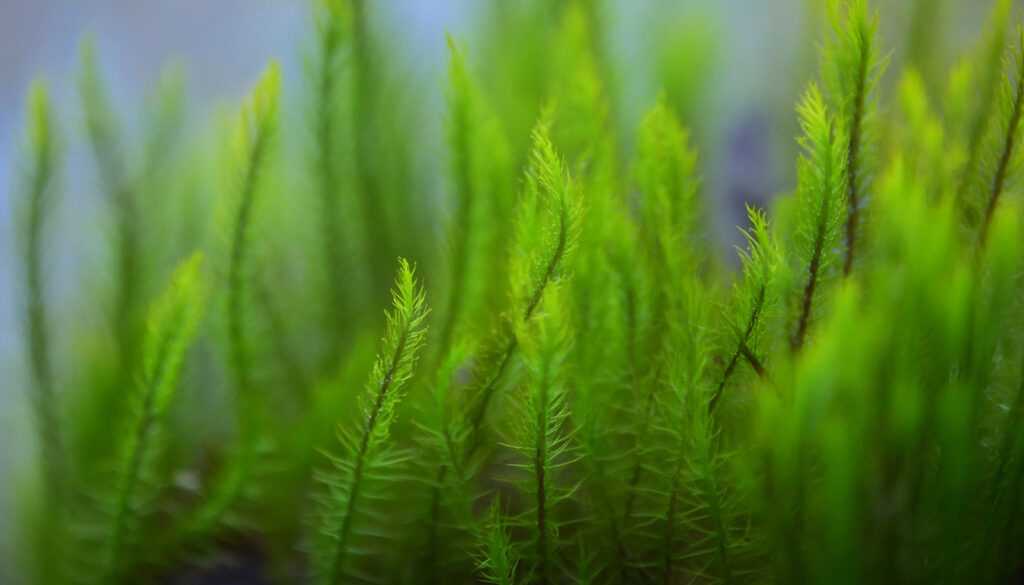
Plant Propagation Tips
- Fragmentation: Flame Moss can be easily propagated by dividing it into smaller portions or fragments. Use sharp scissors or aquascaping tools to carefully cut the moss into manageable sections. Ensure that each fragment has a sufficient number of fronds and rhizoids for successful attachment and growth.
- Attachment: Attach the fragmented portions of Flame Moss to desired surfaces such as rocks, driftwood, or aquarium decorations using fishing line, thread, or glue. Securely anchor the moss fragments to the substrate or hardscape surface to prevent them from floating or drifting away. Press the moss firmly against the surface to ensure good contact and attachment.
- Spacing: When attaching Flame Moss fragments to surfaces, space them evenly to allow room for growth and prevent overcrowding. Avoid clustering too many fragments in one area, as this can inhibit airflow and light penetration, leading to poor growth and potential issues with algae.
The Benefits Of Flame Moss To Aquarium Inhabitants
Providing Shelter and Nutrition for Aquatic Life
- Flame moss offers numerous benefits to the inhabitants of your aquarium. One of the key advantages is that it provides shelter and hiding places for small fish, shrimp, and other aquatic life.
- Flame moss’s dense and tangled growth pattern creates a safe and natural environment, allowing your aquarium inhabitants to feel protected and secure. They can seek refuge within the moss, find comfort, and reduce stress levels.
- Moreover, flame moss serves as a source of nutrition for aquatic organisms. It attracts microorganisms and biofilm, which are vital food sources for many aquarium inhabitants.
- The intricate structure of flame moss provides a perfect habitat for these beneficial organisms to thrive, ensuring a continuous supply of nutrition for your aquatic pets.
Flame Moss as a Biological Filter
- In addition to providing shelter and nutrition, flame moss also acts as a biological filter in your aquarium. Its dense growth aids in absorbing impurities and pollutants present in the water.
- It serves as a natural mechanism for improving water quality by absorbing excess nutrients, such as nitrates and phosphates, that can cause imbalances if left unchecked. By incorporating flame moss into your aquascape, you can create a healthier and more stable environment for your aquarium inhabitants.
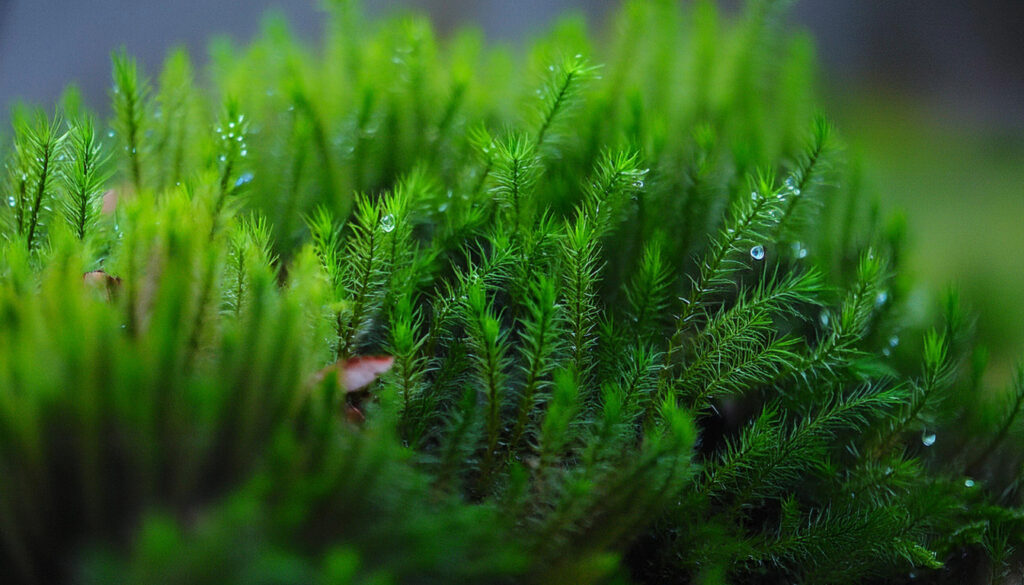
Conclusion
Flame moss (Taxiphyllum sp.) is a remarkable aquatic plant that holds immense value in the world of aquascaping. Throughout this article, we have explored the unique characteristics of flame moss and its various benefits in creating captivating underwater landscapes.
Understanding flame moss’s growth pattern, history, and origin is essential for successfully integrating it into aquascapes.
By providing the right lighting conditions, water parameters, and good water circulation, we can ensure the optimal growth and health of flame moss in our aquariums.
Moreover, we have discussed the importance of regular maintenance and pruning to keep flame moss lush and vibrant.
We can overcome common challenges associated with cultivating flame moss by controlling algae growth, addressing potential pests and diseases, and managing varying water conditions.
As you embark on your own aquascaping journey, we encourage you to consider incorporating flame moss into your designs. Its ability to provide shelter nutrition, and act as a biological filter for aquarium inhabitants makes flame moss a valuable addition to any aquascape.
Use the knowledge gained from this article to create visually stunning aquascapes that showcase the beauty and allure of flame moss.
Frequently Asked Questions
What Are The Common Challenges In Growing Flame Moss?
Like any aquarium plant, flame moss can face challenges such as pests, diseases, and managing fluctuations in water conditions. Common issues include snails feeding on the moss and algae blooms.
It is important to monitor and address these challenges promptly to ensure the healthy growth of flame moss. Regular maintenance, good water quality, and appropriate lighting can help prevent and solve these challenges.
How Can I Incorporate Flame Moss Into My Aquascape Design?
Flame moss can be integrated into your aquascape design in various ways. It can be attached to driftwood, rocks, or the rear glass for a backdrop effect. You can also combine flame moss with other aquatic plants to create diverse and visually stunning aquascapes.
Unleash your creativity and experiment with different placement techniques to achieve your desired design.
What Are The Propagation Techniques For Flame Moss?
Flame moss can be propagated through fragmentation, where portions of the moss are separated and attached to new surfaces. Spore dispersal and division are other propagation methods, each with its own benefits and challenges.
Patience and care are important when propagating flame moss to ensure successful growth and establishment.
How Can I Control Algae In My Flame Moss Tank?
Maintaining good water quality is crucial for controlling algae in a flame moss tank. This includes providing proper lighting, avoiding excessive nutrients, and maintaining regular water changes.
If algae still become problematic, manual removal and the use of algae-eating organisms like shrimp or snails can be considered as additional measures.
What Are Suitable Substrates And Hardscape Materials For Flame Moss Displays?
It is important to choose substrates that complement flame moss and promote its growth. Nutrient-rich aquasoil or gravel with root tabs are suitable options.
When it comes to hardscape, driftwood, and stones can create a natural and aesthetically pleasing look in flame moss displays. Select and position these materials carefully to achieve the desired impact.
- Unveiling The Wonders Of Riccia Fluitans In Aquascapes - August 7, 2024
- Vallisneria Gigantea Var. Guide To Care And Cultivation At Home - July 31, 2024
- Vesicularia Dubyana Care & Growth Guide Tips For Beginner Gardeners - July 30, 2024
